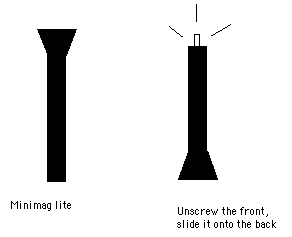
A blue light special
The afterimage produced by moving a maglite across your field of view changes color as it ages. What else can you see?

Material
A mini-maglite, only this brand of flashlight will work for this exploration.
Assembly
Unscrew and completely remove the top of the mini maglite. You should see a small bright point of light.
To Do and Notice
Darken a room, turn off the roomlights, lower the shades. Look straight ahead at a far wall. Wave the maglite around in front of your eyes.
Do not move your eyes. That is, do not follow the moving maglite with your eye, just stare straight ahead.
After 20 seconds or so, notice the trail of light that follows the maglite. (Like the bright trail that follows the bright ember on the end of a stick waved around a campfire.)
Notice that the trail of light changes from yellowish-white to blue and then remains blue for a long time before fading away.
Try moving the maglite so that you tie a knot in the blue afterimage "string."
Notice that if you wave the light in circles that come towards your face and then away that you see a 3-dimensional afterimage.
Close your eyes. Continue to wave the light around outside your closed eyes. Notice that the blue afterimage eventually fades away and is replaced by a blacker-than-black afterimage.
What's Going On?
When a white light moves across one place on your retina the red, green and blue cones in that region produce nerve impulses. The nerve impulses continue to be produced after the light is no longer in that region of the retina. This produces a positive afterimage, or a trail of light which follows a moving light.
The red and green cones cease firing before the blue cones so that the afterimage trail eventually turns blue.
The afterimages occur in both of your eyes, your brain assembles the two eye images into a 3-dimensional afterimage, just as it assembles two eye views of the world into a 3-dimensional view of the world.
With your eyes closed and dimly illuminated by the mini maglite, The cones which have been firing to make the afterimage fire less rapidly in response to the dim illumination than the surrounding cones. The region of the positive afterimage thus becomes blacker than the surrounding region, it becomes a negative afterimage.
The 3-dimensional afterimage was pointed out to me by Ned Kahn.
|
Scientific Explorations with Paul Doherty |
|
18 September 2002 |